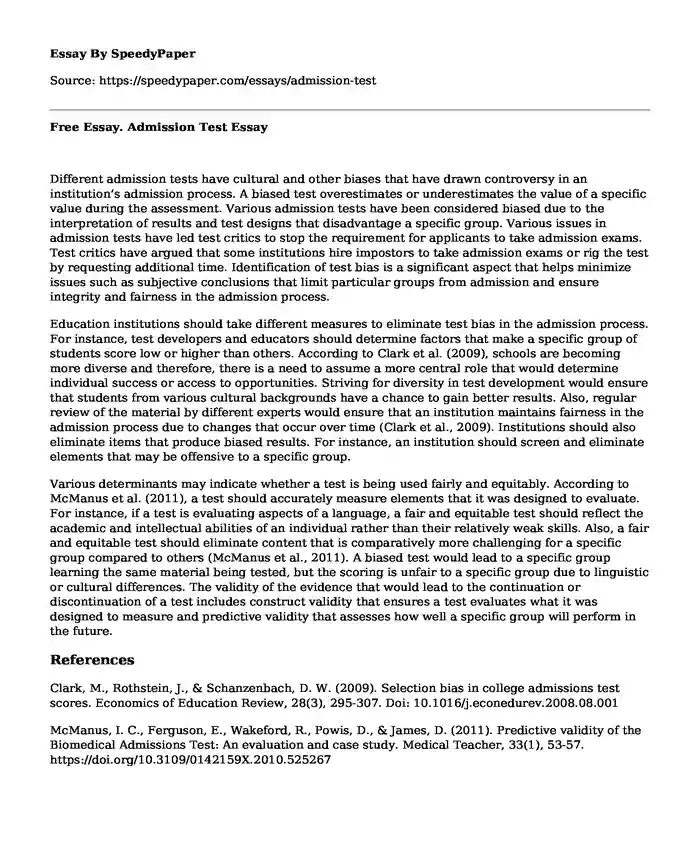
| Essay type: | Persuasive essays |
| Categories: | Knowledge Students Admission help Essays by pagecount |
| Pages: | 2 |
| Wordcount: | 492 words |
Different admission tests have cultural and other biases that have drawn controversy in an institution’s admission process. A biased test overestimates or underestimates the value of a specific value during the assessment. Various admission tests have been considered biased due to the interpretation of results and test designs that disadvantage a specific group. Various issues in admission tests have led test critics to stop the requirement for applicants to take admission exams. Test critics have argued that some institutions hire impostors to take admission exams or rig the test by requesting additional time. Identification of test bias is a significant aspect that helps minimize issues such as subjective conclusions that limit particular groups from admission and ensure integrity and fairness in the admission process.
Education institutions should take different measures to eliminate test bias in the admission process. For instance, test developers and educators should determine factors that make a specific group of students score low or higher than others. According to Clark et al. (2009), schools are becoming more diverse and therefore, there is a need to assume a more central role that would determine individual success or access to opportunities. Striving for diversity in test development would ensure that students from various cultural backgrounds have a chance to gain better results. Also, regular review of the material by different experts would ensure that an institution maintains fairness in the admission process due to changes that occur over time (Clark et al., 2009). Institutions should also eliminate items that produce biased results. For instance, an institution should screen and eliminate elements that may be offensive to a specific group.
Various determinants may indicate whether a test is being used fairly and equitably. According to McManus et al. (2011), a test should accurately measure elements that it was designed to evaluate. For instance, if a test is evaluating aspects of a language, a fair and equitable test should reflect the academic and intellectual abilities of an individual rather than their relatively weak skills. Also, a fair and equitable test should eliminate content that is comparatively more challenging for a specific group compared to others (McManus et al., 2011). A biased test would lead to a specific group learning the same material being tested, but the scoring is unfair to a specific group due to linguistic or cultural differences. The validity of the evidence that would lead to the continuation or discontinuation of a test includes construct validity that ensures a test evaluates what it was designed to measure and predictive validity that assesses how well a specific group will perform in the future.
References
Clark, M., Rothstein, J., & Schanzenbach, D. W. (2009). Selection bias in college admissions test scores. Economics of Education Review, 28(3), 295-307. Doi: 10.1016/j.econedurev.2008.08.001
McManus, I. C., Ferguson, E., Wakeford, R., Powis, D., & James, D. (2011). Predictive validity of the Biomedical Admissions Test: An evaluation and case study. Medical Teacher, 33(1), 53-57. https://doi.org/10.3109/0142159X.2010.525267
Cite this page
Free Essay. Admission Test. (2023, Nov 19). Retrieved from https://speedypaper.com/essays/admission-test
Request Removal
If you are the original author of this essay and no longer wish to have it published on the SpeedyPaper website, please click below to request its removal:
- Narrative Argument about Education, Free Essay
- Free Essay Example on Ron Popeil
- Free Essay Comparing and Contrasting Films
- Free Essay about Application of Egoism to an Ethical Issue Like Abortion
- Free Paper on Androgenetic Alopecia Treatment
- Free Essay Sample on Urban Sprawl
- Free Essay - Popular Cultural Representation of the Human Body
Popular categories




